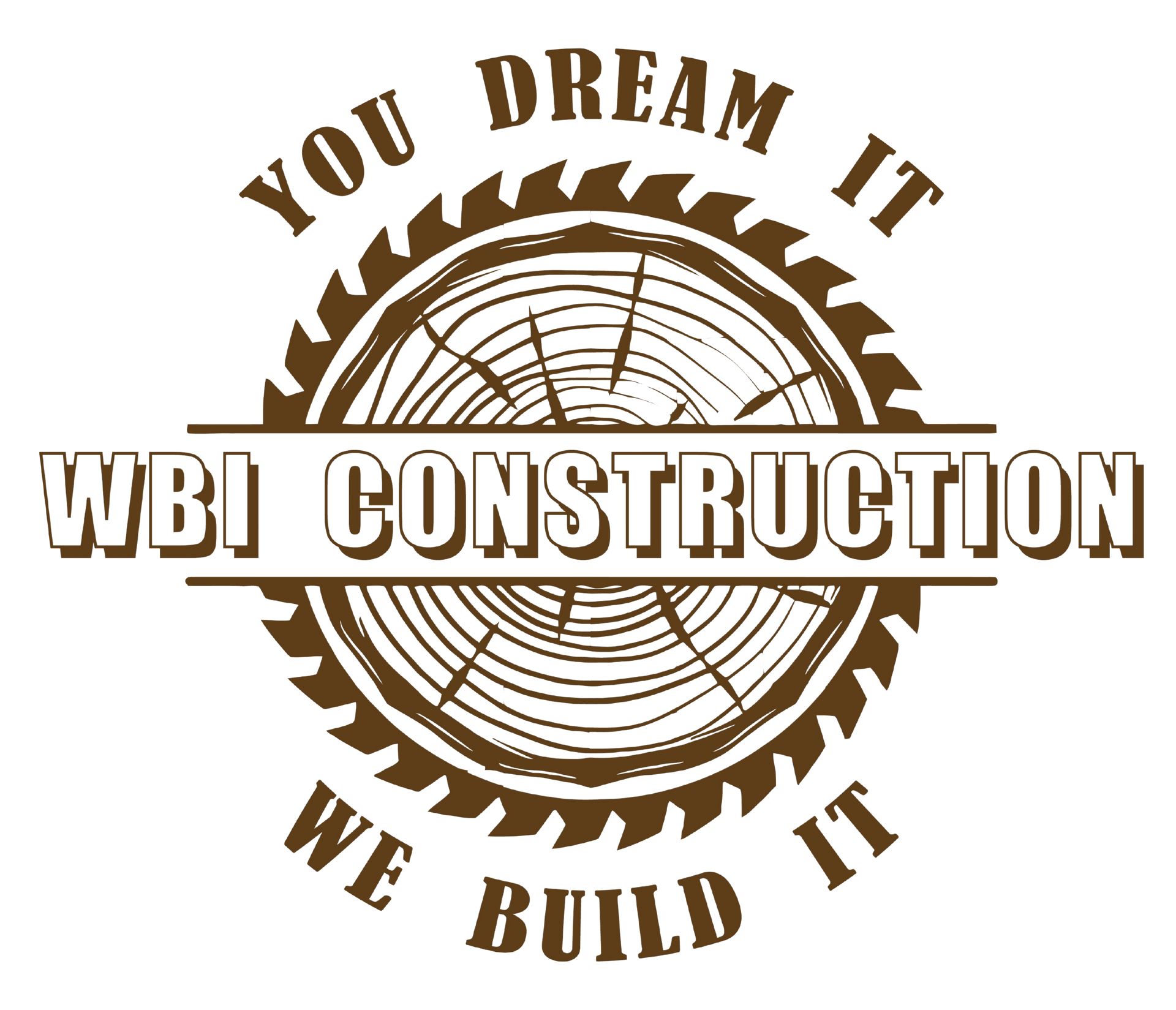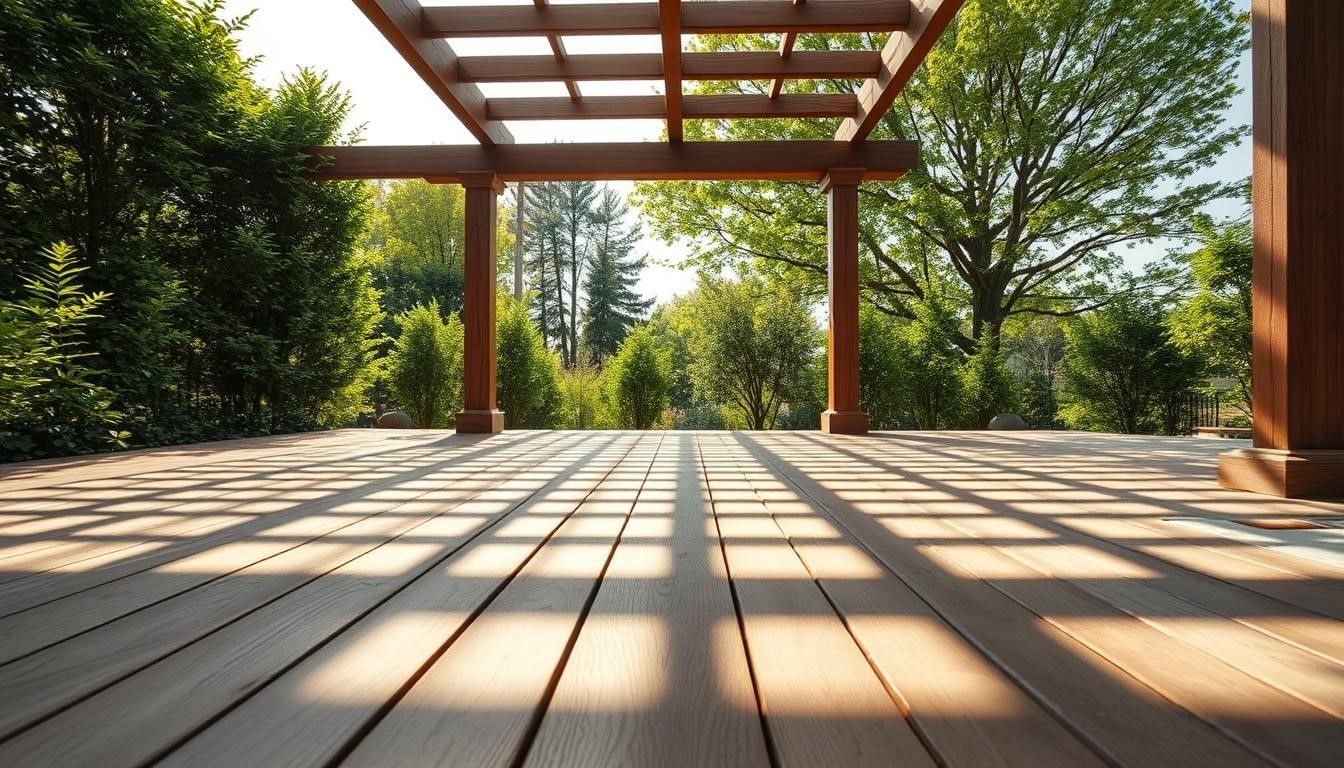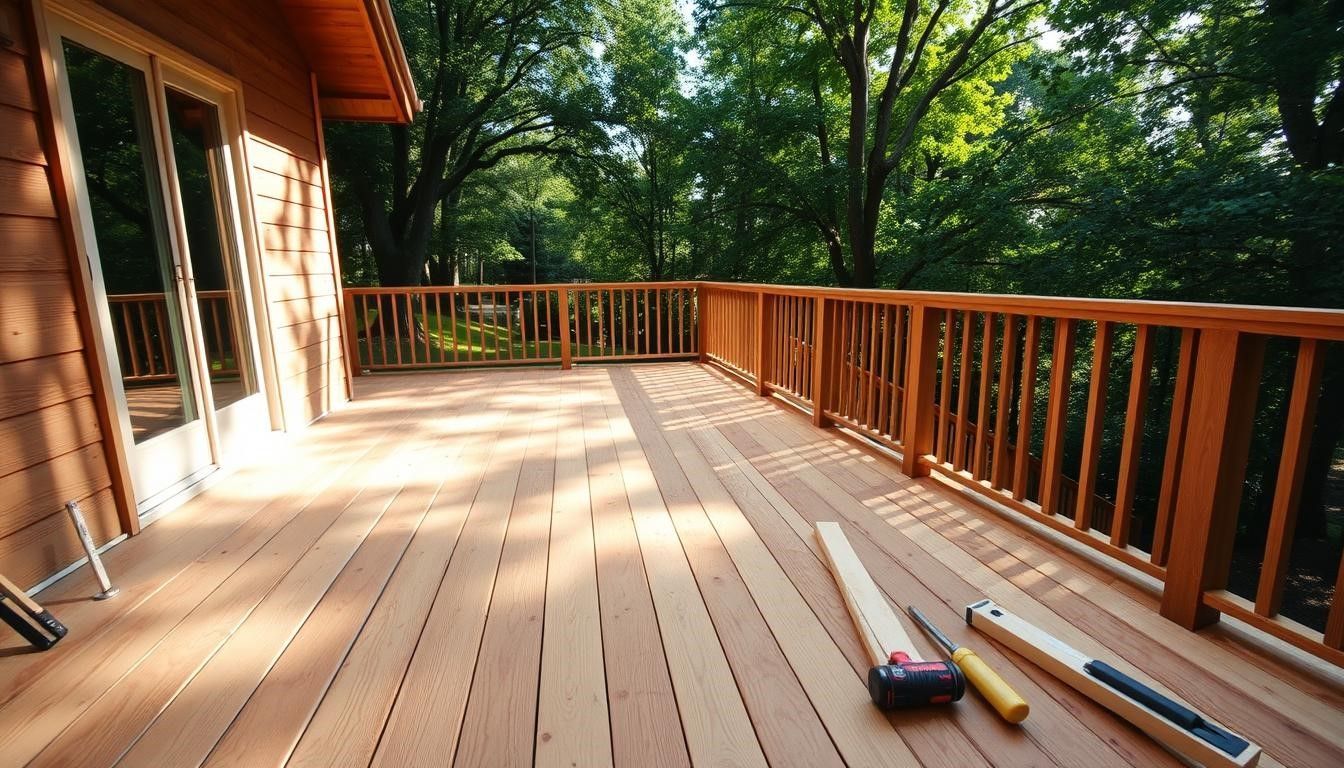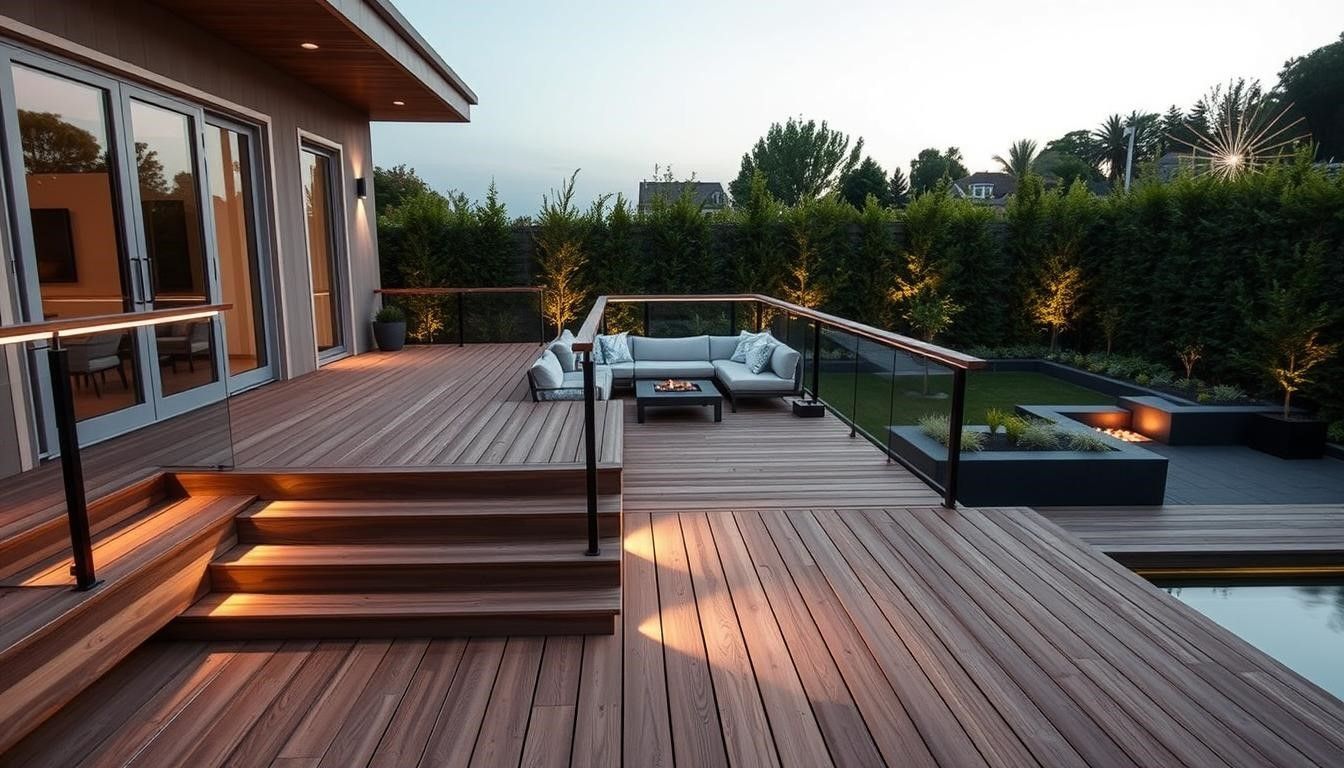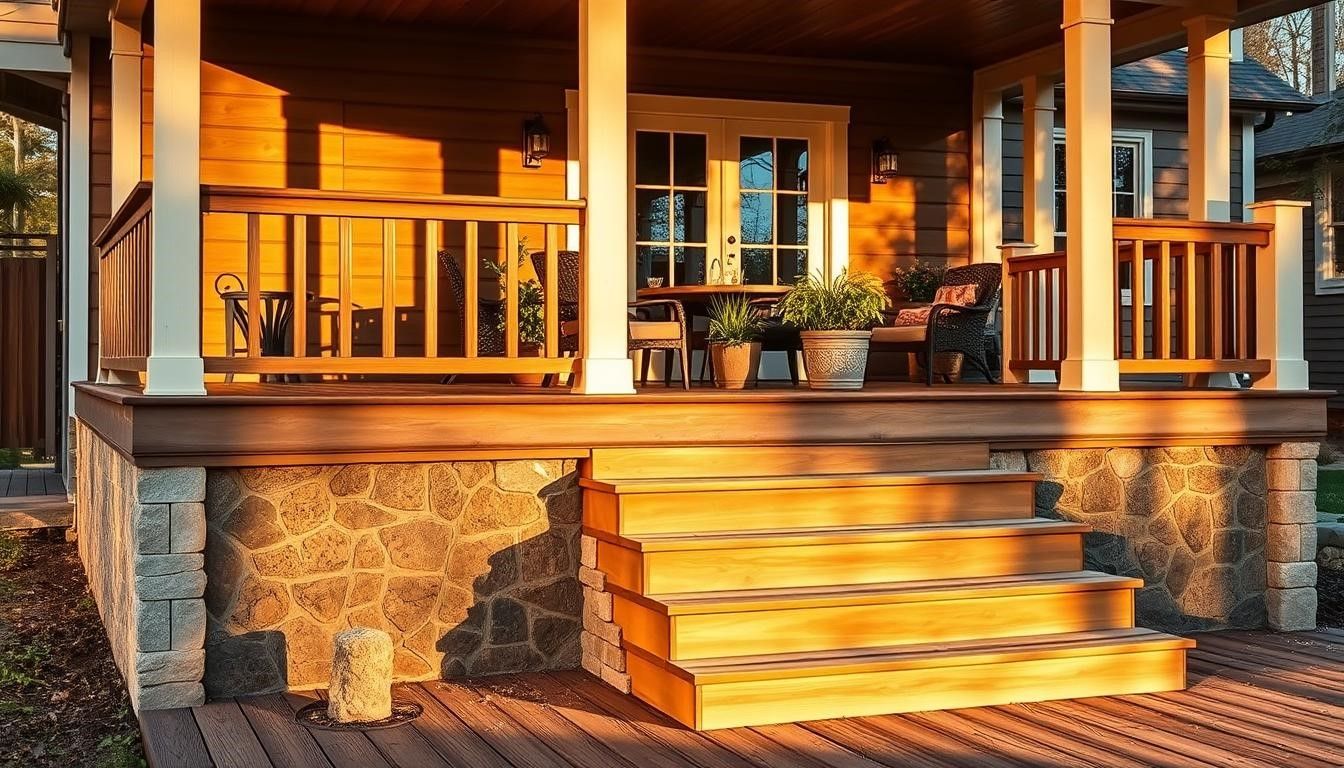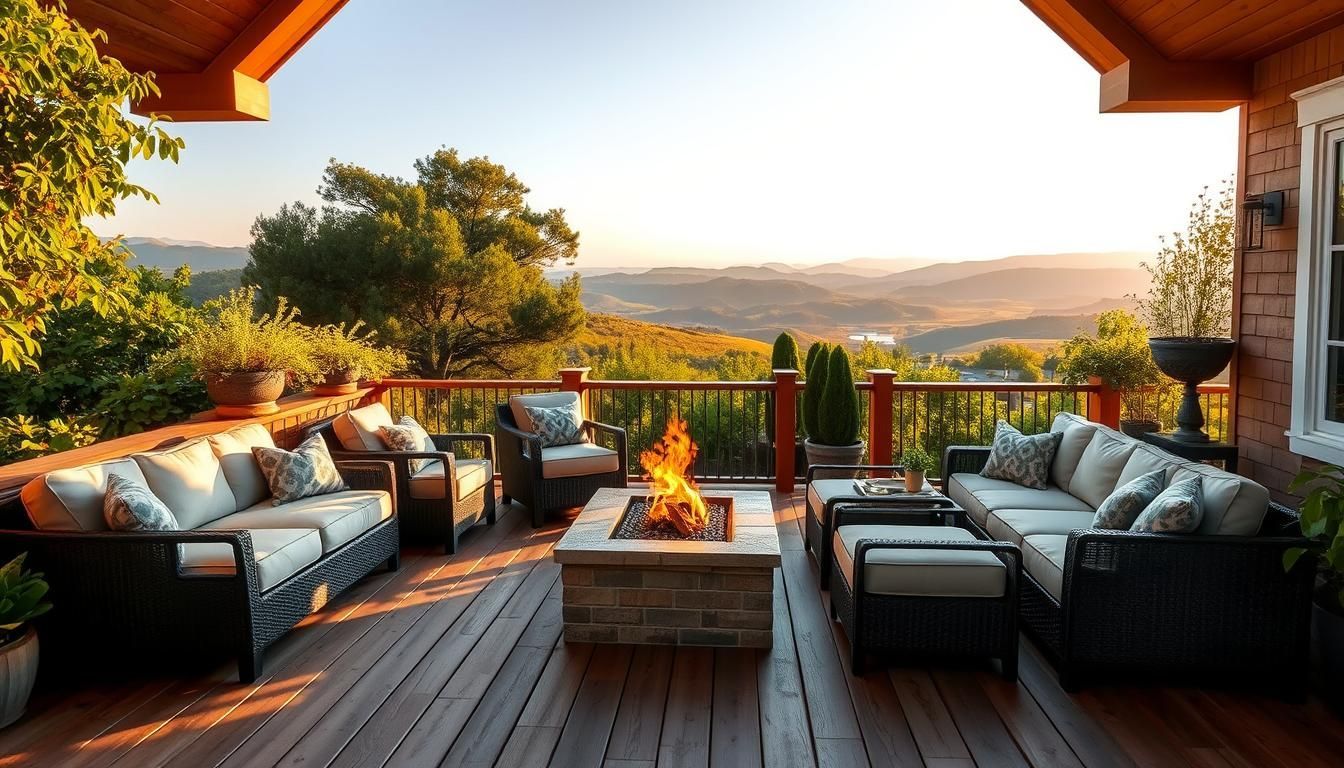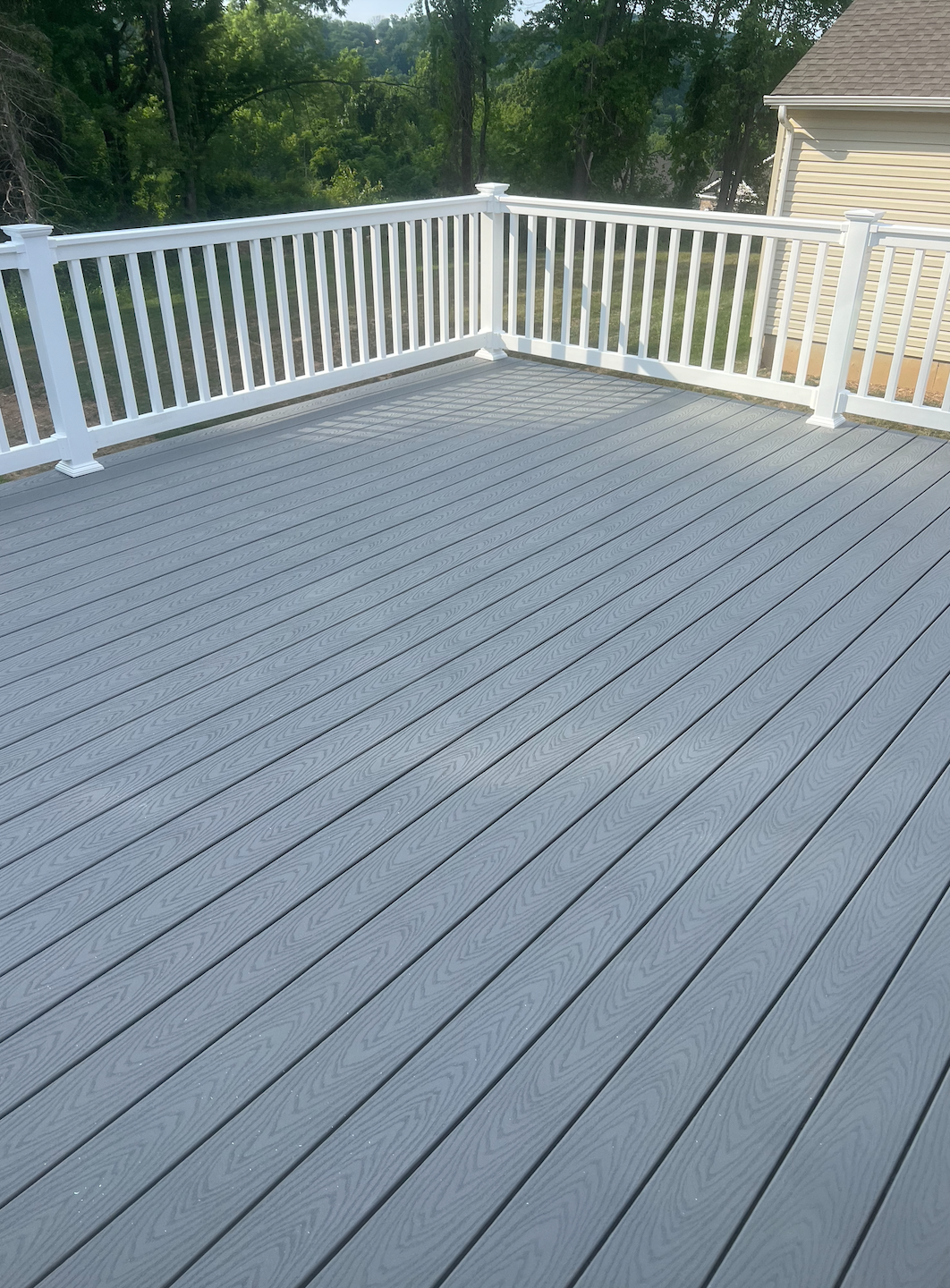Beyond Wood: A Guide to Composite vs. PVC Decking for Durability and Low Maintenance
When it comes to outdoor spaces, traditional wood is no longer the only option. Modern materials offer superior performance, durability, and low maintenance. If you’re looking for a long-lasting solution, synthetic options are worth considering.
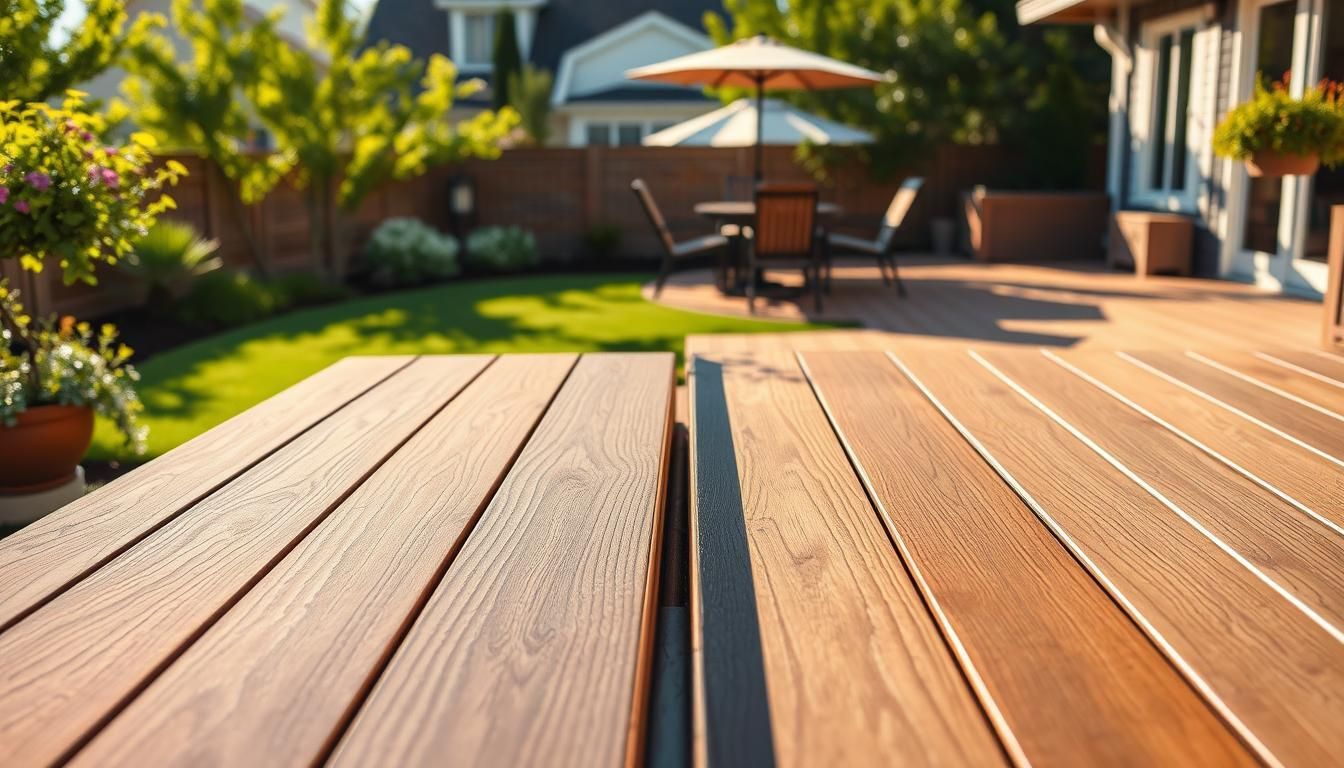
WBI Construction, , with over 30 years of experience, specializes in helping homeowners choose the right decking for their needs. Whether it’s lifespan, cost, or aesthetics, we guide you through every step. Synthetic materials also come with impressive warranties, some lasting up to 50 years.
These alternatives are not only durable but also environmentally friendly compared to natural wood. Their popularity has surged, with the market growing by 80% since 2015. For maximum durability, professional installation is key.
Key Takeaways
- Modern materials outperform traditional wood in durability and maintenance.
- WBI Construction offers expert guidance for choosing the right decking.
- Synthetic options come with warranties of up to 50 years.
- Professional installation ensures long-lasting results.
- These materials are eco-friendly and growing in popularity.
Introduction to Composite vs. PVC Decking
The demand for durable and low-maintenance decking materials has skyrocketed. Homeowners are now choosing synthetic options over traditional wood for their outdoor spaces. Since 2010, the engineered decking market has tripled, with 68% of new decks using these advanced materials.
One of the biggest differences lies in material composition. PVC is made entirely of plastic, while composite blends wood fibers with plastic. This impacts everything from heat retention to recyclability. For example, PVC decks stay 30°F cooler than composites in direct sunlight, making them a popular choice for sunny climates.
At WBI Construction, we guide homeowners through the selection process. Our consultation ensures you choose the right material for your needs. We address common misconceptions, like the idea that "plastic" decks lack durability or aesthetic appeal. In reality, both options require 90% less upkeep than wood and come in a variety of textures and colors.
Here’s a quick comparison of key features:
| Feature | PVC | Composite |
|---|---|---|
| Material | 100% plastic | Wood-plastic blend |
| Heat Retention | Stays cooler | Retains more heat |
| Recyclability | Fully recyclable | Partially recyclable |
Our project portfolio showcases the versatility of both materials. From coastal homes to urban patios, we’ve helped countless clients transform their outdoor spaces. Let us help you make the right choice for your deck.
What is Composite Decking?
Outdoor living spaces have evolved with innovative materials. One standout option is composite decking, a blend of wood fibers and plastic. This hybrid material offers the best of both worlds—natural aesthetics and modern durability.
Typically, these products consist of 60-70% wood fibers combined with recycled plastics, like milk jugs and sawdust. This eco-friendly approach reduces waste while creating long-lasting decking made for outdoor use.
Premium options often feature advanced technologies like MoldGuard, which resists mold and mildew. Capped boards, with a protective outer layer, further enhance performance by preventing moisture damage. Uncapped boards, while more affordable, may require more maintenance over time.
Here’s a quick comparison of capped and uncapped boards:
| Feature | Capped Boards | Uncapped Boards |
|---|---|---|
| Moisture Resistance | High | Moderate |
| Maintenance | Low | Moderate |
| Cost | Higher | Lower |
At WBI Construction, we recommend trusted brands like TimberTech for their realistic wood textures and durability. Their Legacy Collection is a favorite among homeowners for its natural look and feel.
"Composite decking is a game-changer for outdoor spaces. It combines beauty, durability, and sustainability in one package."
Keep in mind that these materials are heavier than PVC, which may affect installation. For maintenance, an annual power wash is all it takes to keep your deck looking fresh.
Choosing the right material can transform your outdoor space. Let WBI Construction guide you through the process to ensure you get the best results.
What is PVC Decking?
For homeowners seeking a durable and low-maintenance solution, PVC decking is a top choice. Made entirely from polyvinyl chloride, this 100% synthetic material resists rot, warping, and fading. It’s a reliable option for outdoor spaces that require minimal upkeep.
Advanced co-extrusion manufacturing ensures these decking made products are both strong and lightweight. This process creates a dense core surrounded by a protective outer layer, enhancing durability and performance. The result is a material that withstands harsh weather conditions without compromising on aesthetics.
One standout example is the AZEK Vintage Collection, known for its realistic wood-grain textures. This plastic decking mimics the look of natural wood while offering superior longevity. Its heat dissipation properties also make it a cooler option underfoot compared to other materials.
| Feature | PVC | Composite |
|---|---|---|
| Density | Lighter | Heavier |
| Handling | Easier | More Challenging |
At WBI Construction, we emphasize proper spacing during installation to prevent thermal expansion issues. This pro tip ensures your deck remains stable and visually appealing for years to come.
Some homeowners worry about the plastic appearance of PVC. However, modern designs like the AZEK Vintage Collection have addressed this concern. With realistic textures and colors, these decks blend seamlessly into any outdoor setting.
Our coastal project highlights the material’s saltwater resistance. In this installation, we used PVC decking to create a stunning, long-lasting space that withstands the harsh marine environment. This showcases the versatility and durability of this innovative material.
Durability: Composite vs. PVC Decking
Choosing the right material for your outdoor space is crucial for long-term satisfaction. Both synthetic options offer impressive durability, but they excel in different areas. Understanding their strengths can help you make an informed decision.
How Composite Materials Hold Up Over Time
Composite materials are known for their lifespan and resistance to heavy use. They are ideal for areas with heavy furniture, as they can withstand significant weight without warping. Structural warranties for these products often last up to 30 years, ensuring long-term peace of mind.
In wet climates, composite materials may require extra protection against moisture. However, capped boards with advanced technologies like MoldGuard offer enhanced resistance to mold and mildew. For example, a WBI project from 15 years ago still looks pristine, showcasing the material’s longevity.
PVC’s Long-Term Performance
PVC materials are designed to resist scratching and fading, making them a durable choice for high-traffic areas. Their structural warranties often extend up to 50 years, outperforming composites in this regard. Additionally, PVC’s moisture resistance makes it superior in wet climates.
Thermal expansion rates are another key factor. PVC expands at 0.7%, compared to composite’s 1.2%, ensuring stability in varying temperatures. This material also handles hail better, thanks to its impact resistance.
| Feature | Composite | PVC |
|---|---|---|
| Structural Warranty | 30 years | 50 years |
| Scratch Resistance | Moderate | High |
| Moisture Resistance | Good | Excellent |
| Thermal Expansion | 1.2% | 0.7% |
At WBI Construction, we stand by our work with a 10-year workmanship warranty on all installations. Our lifetime craftsmanship guarantee ensures your deck remains a lasting investment. Let us help you choose the best material for your needs.
Maintenance Requirements: Which is Easier to Care For?
Keeping your outdoor space in top shape doesn’t have to be a chore. Both synthetic options are designed for low maintenance, but there are some differences in care routines.
Annual upkeep for PVC takes about 2 hours, while composites may require up to 4 hours. This includes basic cleaning with soap and water. However, composites often need more frequent washing to prevent surface mildew.
Mold removal is straightforward for both materials. For PVC, a mild detergent and soft brush work well. Composites may require a specialized cleaner to address mildew buildup. WBI Construction recommends trusted products like Mold Armor for effective results.
Here’s a quick comparison of annual maintenance needs:
| Feature | PVC | Composite |
|---|---|---|
| Annual Time | 2 hours | 4 hours |
| Mold Removal | Mild detergent | Specialized cleaner |
| Stain Resistance | High | Moderate |
Stain resistance is another key factor. Both materials handle common spills like wine, grease, and sunscreen well. However, PVC tends to resist staining better over time.
For seasonal care, a simple checklist can keep your space looking great:
- Spring: Inspect for damage and clean thoroughly.
- Summer: Remove debris and check for mold.
- Fall: Clear leaves and apply protective treatments if needed.
- Winter: Remove snow and ice carefully.
WBI Construction offers professional deep-cleaning services to save you time and effort. Our team uses advanced techniques to restore your deck’s original beauty. Neither material requires sealing, making them even more convenient for homeowners.
"Regular maintenance ensures your outdoor space remains a welcoming retreat for years to come."
Let WBI Construction handle the details so you can enjoy your deck without the hassle. Our maintenance packages are tailored to your needs, ensuring your investment stays in pristine condition.
Cost Comparison: Composite vs. PVC Decking
Understanding the financial aspects of your outdoor project is essential for making the best decision. Both synthetic options come with different cost structures, and knowing the details can help you stay within your budget.
On average, PVC costs between $10 to $15 per square foot installed, while composite ranges from $8 to $12. This includes both materials and labor. However, the initial price is just one factor to consider.
- Material/Labor Cost Ratios: Labor typically accounts for 40-50% of the total cost, regardless of the material chosen.
- ROI Comparison: PVC offers a 75% return on investment, while composite provides 68%.
- Hidden Costs: Substructure requirements, like joists and beams, can add to the overall expense.
WBI Construction simplifies the process with our price-match guarantee. We ensure you get the best value for your investment. Additionally, we offer flexible financing options to make your outdoor project more affordable.
"Investing in quality materials upfront saves you money in the long run. Our team ensures every dollar is well spent."
When comparing to traditional wood, synthetic options may have a higher initial cost, but their durability and low maintenance lead to significant savings over time. For example, the 10-year cost of ownership for wood can be up to 30% higher due to frequent repairs and replacements.
For larger projects, WBI offers bulk purchase discounts. This can reduce your overall budget while ensuring you get premium materials. Our team works closely with you to create a plan that fits your financial goals.
At WBI Construction, we believe in transparency and value. Let us help you make an informed decision that balances quality and affordability for your outdoor space.
Aesthetic Appeal: Which Looks Better?
The visual appeal of your outdoor space can transform it into a true retreat. When choosing materials, aesthetics play a crucial role in creating a cohesive and inviting environment. Both synthetic options offer unique design features, but they cater to different preferences.
Natural Wood Look of Composite Materials
For those who love the warmth of natural wood, composite materials are a top choice. Their wood grain textures mimic real timber, offering a classic and timeless appearance. In fact, 78% of homeowners prefer this texture for its authentic feel.
Surface embossing techniques enhance the realism, creating intricate patterns that resemble hand-scraped or brushed wood. These options are perfect for traditional or rustic outdoor spaces. Additionally, composite materials come in a variety of shades, from light oak to rich mahogany.
Modern Finish of PVC Materials
PVC materials, on the other hand, offer a sleek and contemporary style. With over 40 color options, they cater to modern design preferences. Their smooth finishes and bold hues make them ideal for urban or minimalist settings.
One standout feature is their ability to retain color 30% longer than composites. This ensures your outdoor space stays vibrant for years. Popular choices include slate gray and coastal blue, which are trending for 2024.
| Feature | Compostie | PVC |
|---|---|---|
| Texture | Wood grain | Smooth finish |
| Color Retention | Moderate | High |
| Design Flexibility | Traditional | Modern |
Lighting also plays a role in enhancing the appearance of your deck. Natural sunlight highlights the wood grain of composites, while LED lighting can accentuate the bold colors of PVC. WBI Construction’s augmented reality preview system allows you to visualize these effects before making a decision.
"Choosing the right aesthetic ensures your outdoor space reflects your personal style and enhances your home’s overall appeal."
Board width and railing system compatibility are additional factors to consider. Wider boards create a more spacious look, while matching railings complete the design. At WBI Construction, we help you explore all options to create a deck that’s both beautiful and functional.
Environmental Impact: Composite vs. PVC Decking
Sustainability is a key factor when choosing materials for your outdoor space. Both synthetic options offer eco-friendly benefits, but their environmental impacts differ. Understanding these differences can help you make a greener choice.
PVC uses 92% recycled materials, making it a leader in waste reduction. Composites, on the other hand, blend 60-70% wood fibers with recycled plastics. This process reduces landfill waste while creating durable outdoor solutions.
- Manufacturing Carbon Footprint: PVC production uses less energy compared to composites, reducing greenhouse gas emissions.
- End-of-Life Recyclability: PVC is fully recyclable, while composites are partially recyclable due to their wood content.
- Energy Use: PVC’s manufacturing process is more energy-efficient, contributing to its lower environmental impact.
WBI Construction is committed to sustainability. Our solar-powered workshop reduces energy consumption, and our material take-back program ensures old materials are recycled responsibly. We also source locally whenever possible, minimizing transportation emissions.
"Choosing eco-friendly materials not only benefits the environment but also enhances the longevity of your outdoor space."
By opting for synthetic materials, you’re also contributing to forest conservation. These alternatives reduce the need for natural wood, preserving forests for future generations. WBI’s LEED-certified projects further highlight our dedication to green building practices.
Let WBI Construction guide you in creating an outdoor space that’s both beautiful and environmentally responsible. Our expertise ensures your project aligns with your sustainability goals.
Installation Process: Composite vs. PVC Decking
The right installation process can make or break your outdoor project. Whether you’re considering a DIY approach or hiring professionals, understanding the steps involved ensures a smooth and durable result.
For DIY enthusiasts, tools like circular saws, drills, and levels are essential. PVC materials are 30% lighter, making them easier to handle. However, they require specialized fasteners to prevent warping. Composites, being heavier, may need additional support during installation.
Substructure preparation differs between materials. PVC requires precise spacing to account for thermal expansion, while composites need a solid base to support their weight. WBI Construction’s certified team ensures every detail is addressed, from joist spacing to hidden fastener systems.
- Timeline Guarantees: WBI completes most projects within 2-3 weeks, weather permitting.
- Hidden Fasteners: These systems create a seamless look, enhancing the overall aesthetic.
- Expansion Gaps: Proper spacing prevents buckling and ensures long-term stability.
Labor costs vary by material. PVC installation averages $10-$15 per square foot, while composites range from $8-$12. WBI’s precision cutting technology minimizes waste, keeping costs within your budget.
"Professional installation not only saves time but also protects your warranty. DIY mistakes can void coverage, leaving you unprotected."
WBI Construction offers a 10-year workmanship warranty, ensuring your investment is secure. Our team’s expertise guarantees a flawless finish, whether you choose PVC or composites. Let us handle the details so you can enjoy your outdoor space worry-free.
Comfort and Safety Features
Your outdoor space should be both comfortable and safe for everyone. At WBI Construction, we prioritize safety features to ensure your home meets all your needs. Whether it’s heat resistance or slip prevention, we’ve got you covered.
Surface temperature is a key factor in comfort. PVC stays 15°F cooler than other materials, making it ideal for sunny climates. Composites, on the other hand, are better for bare feet, especially in cooler areas.
Here’s how we ensure your space is safe and functional:
- Slip Resistance: Both materials meet ASTM D2394 standards, but PVC offers higher ratings for wet conditions.
- Heat-Reflective Coatings: These reduce surface heat, keeping your deck comfortable even on hot days.
- Child-Safe Railings: Our custom systems are designed to prevent accidents while maintaining style.
Composites are splinter-free, making them safer for kids and pets. PVC’s smooth surface also eliminates this risk. Both materials absorb sound, reducing noise from footsteps or furniture.
Impact tests show PVC outperforms composites in durability. This makes it a great choice for high-traffic areas. Our team ensures every installation meets ADA compliance, providing accessibility for all users.
"Safety and comfort go hand in hand. At WBI, we design outdoor spaces that families can enjoy without worry."
Let WBI Construction help you create a space that’s both beautiful and secure. Our expertise ensures your outdoor area meets the highest standards of safety and comfort.
Weather Resistance: Composite vs. PVC Decking
Weather can be unpredictable, but your outdoor space doesn’t have to be. Choosing the right materials ensures your deck withstands the elements for years to come. Both synthetic options excel in weather resistance, but their performance varies depending on the climate.
PVC can handle extreme temperatures, from -40°F to 140°F, making it ideal for regions with harsh winters or scorching summers. Composites, on the other hand, perform well between -30°F and 120°F. This makes them suitable for moderate climates but less effective in extreme conditions.
Here’s how these materials perform in specific weather scenarios:
- Freeze-Thaw Cycles: PVC resists cracking better than composites, ensuring durability in cold climates.
- Hurricane-Rated Installations: PVC’s lightweight and flexible nature makes it a top choice for storm-prone areas.
- Coastal Corrosion: Both materials resist saltwater damage, but PVC’s non-porous surface offers extra protection against corrosion.
UV stabilization is another key factor. PVC retains its color 30% longer than composites, thanks to advanced UV inhibitors. This ensures your deck stays vibrant even after years of sun exposure.
WBI Construction’s climate-specific recommendations include:
| Feature | PVC | Composite |
|---|---|---|
| Hail Damage Resistance | High | Moderate |
| Snow Load Capacity | Excellent | Good |
| Drainage System Design | Optimized for heavy rain | Standard |
Our 5-year weathering study shows PVC outperforms composites in durability, especially in extreme conditions. For example, a coastal project from 2018 still looks pristine, showcasing PVC’s long-term resilience.
"Choosing the right material for your climate ensures your outdoor space remains beautiful and functional for decades."
At WBI Construction, we design drainage systems to prevent water pooling and mold growth. Our expertise ensures your deck is built to last, no matter the weather. Let us help you create a space that’s as durable as it is stunning.
Customization Options for Your Deck
Transform your outdoor space with endless possibilities for personalization. At WBI Construction, we believe your deck should reflect your unique style and meet your specific needs. With over 200 color combinations and mix-and-match systems, the options are limitless.
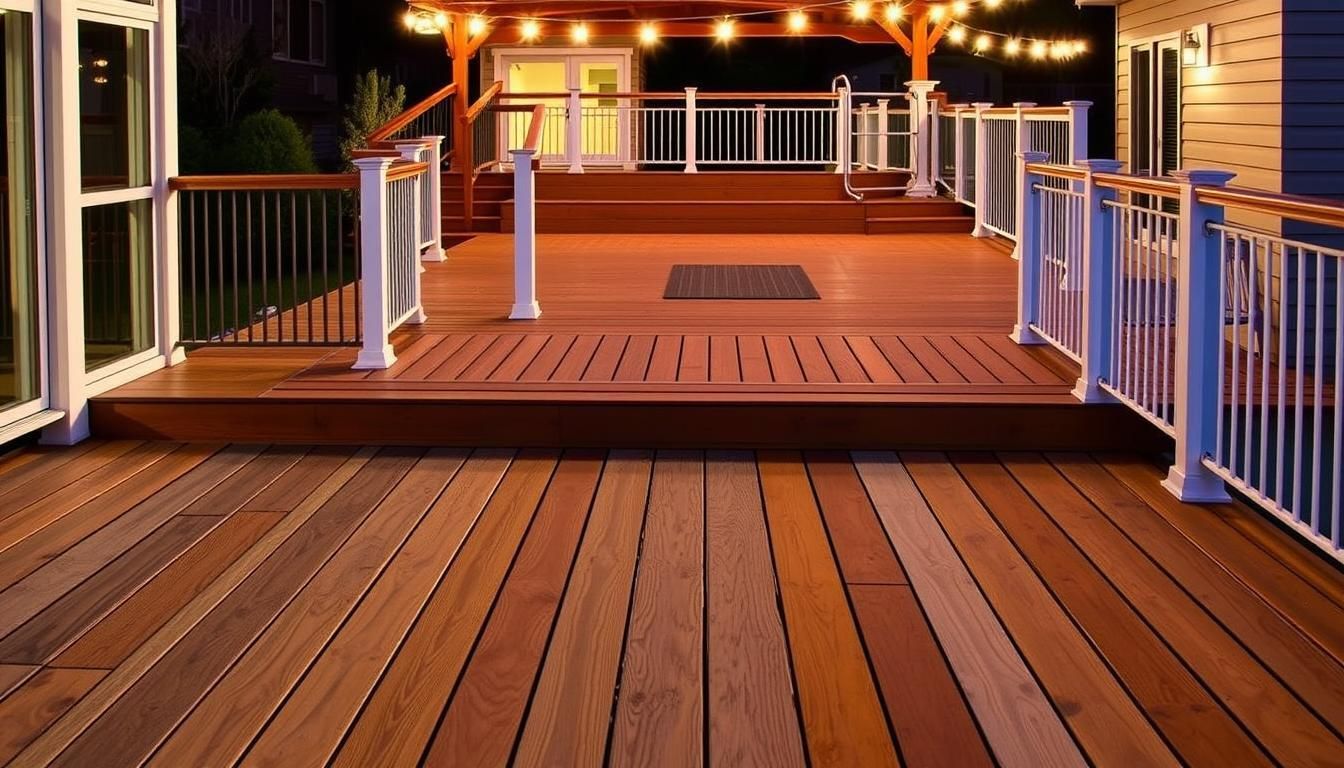
Our 3D design studio allows you to visualize your dream deck before construction begins. Experiment with different patterns, colors, and layouts to create a space that’s uniquely yours. Whether you prefer a classic look or a modern design, we’ve got you covered.
Here are some of our most popular customization options:
- Border Inlays: Add a touch of elegance with contrasting borders that frame your deck beautifully.
- Lighting Integration: Enhance ambiance with built-in LED lights that illuminate your space at night.
- Curved Designs: Create a standout feature with our signature curved deck designs.
- Accessory Compatibility: Pair your deck with benches, planters, and other accessories for added functionality.
Pattern creation techniques allow you to mix and match boards for a one-of-a-kind look. From herringbone to diagonal layouts, the possibilities are endless. Our team will guide you through the process to ensure your vision comes to life.
"A well-designed deck isn’t just an outdoor space—it’s an extension of your home."
For those looking to elevate their design, fascia board options and multi-level layouts add depth and dimension. Whether you’re hosting gatherings or enjoying quiet evenings, your deck will be a space you’ll love for years to come.
At WBI Construction, we’re committed to helping you create a deck that’s as unique as you are. Let us turn your vision into reality with our expert customization options and innovative design tools.
Why Choose WBI Construction for Your Decking Project
Creating the perfect outdoor space requires expertise, reliability, and a trusted partner. At WBI Construction, we bring over 30 years of experience as a family-owned business to every project. Our commitment to quality and customer satisfaction ensures your vision becomes a reality.
Our Commitment to Quality and Customer Satisfaction
We pride ourselves on our "White Glove" project management process. From initial consultation to final installation, our trustworthy team handles every detail with precision. This approach has earned us an A+ rating from the Better Business Bureau and a 98% customer satisfaction rate.
Our material procurement advantages ensure you get the best products for your home. We source high-quality materials directly from trusted manufacturers, saving you time and money. Additionally, our emergency repair services are available to address any unexpected issues quickly.
Transform Your Vision into Reality with WBI Construction
Our certifications, including NARI and EPA Lead-Safe, reflect our dedication to excellence. We stay updated on industry standards to deliver safe and sustainable solutions. Whether it’s a custom design or a simple upgrade, we’re here to make your dream outdoor space a reality.
| Certification | Description |
|---|---|
| NARI | National Association of the Remodeling Industry |
| EPA Lead-Safe | Ensures safe practices for lead-based paint projects |
"WBI Construction transformed our backyard into a stunning retreat. Their attention to detail and professionalism were unmatched!" – Sarah T., Recent Client
Ready to start your project? Contact us today at 732-718-3068 or visit www.wbicrew.com to schedule a consultation. Let us help you create an outdoor space you’ll love for years to come.
Conclusion: Making the Right Choice for Your Deck
Your outdoor project deserves the perfect materials to match your vision. Whether it’s durability, low maintenance, or aesthetic appeal, understanding your needs is the first step. With 92% of WBI clients satisfied with their material choice, we’re here to guide you every step of the way.
To make your decision easier, we offer a free material sample kit. Explore textures and colors to find the best fit for your home. Plus, take advantage of our seasonal discount offer for extra savings.
Ready to start? Our consultation process is simple and stress-free. Call 732-718-3068 for your free estimate. With our lifetime craftsmanship guarantee and limited-time financing options, your dream deck is closer than ever.
Frequently Asked Questions About compostie vs. pvc decking
What is the main difference between composite and PVC decking?
Composite decking combines wood fibers and recycled materials, offering a natural wood look. PVC decking is made entirely from polyvinyl chloride, providing a sleek, modern finish.
Which material is more durable for outdoor use?
Both materials are durable, but PVC decking tends to resist moisture and mold better, making it ideal for humid climates. Composite decking is strong but may require more protection in extreme weather.
How do maintenance needs compare between the two?
PVC decking requires minimal upkeep, needing only occasional cleaning. Composite decking also has low maintenance but may need sealing over time to maintain its appearance.
Are there eco-friendly options available?
Yes, composite decking often uses recycled materials, making it a greener choice. PVC decking is recyclable but made from synthetic materials, which may have a higher environmental impact.
Which material offers more design options?
Composite decking mimics natural wood grain, offering a classic look. PVC decking provides a variety of colors and finishes for a modern aesthetic.
How do installation processes differ?
Both materials are easy to install, but PVC decking is lighter and may be quicker to handle. Composite decking requires similar tools and techniques to traditional wood decking.
Which is better for hot climates?
PVC decking stays cooler underfoot in hot weather, making it a comfortable choice for sunny areas. Composite decking can retain heat but is still a reliable option.
Can these materials withstand harsh weather?
Both are weather-resistant, but PVC decking excels in wet conditions due to its moisture resistance. Composite decking performs well but may need extra care in extreme climates.
Which is more cost-effective in the long run?
PVC decking often has a higher upfront cost but requires less maintenance over time. Composite decking is affordable initially and offers a long lifespan with proper care.
Why choose WBI Construction for decking projects?
WBI Construction ensures top-quality materials and craftsmanship, transforming your vision into a stunning, durable deck tailored to your needs.
